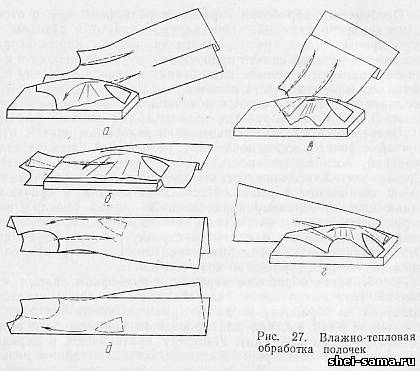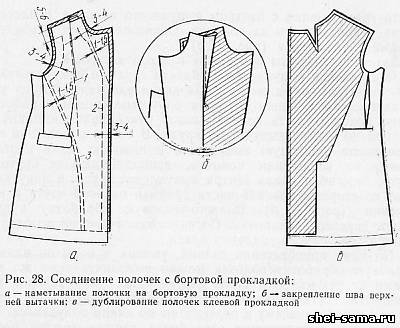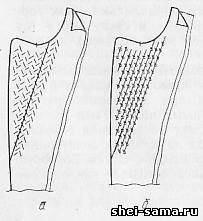Wet-heat processing shelves
For stivania  shelves and give them a convex shape in the chest area shelves are treated with iron clasped together, right sides inside with the equalization of all sections or each separately (depending on tissue thickness). When you perform the wet-heat treatment using the following techniques (Fig. 27). shelves and give them a convex shape in the chest area shelves are treated with iron clasped together, right sides inside with the equalization of all sections or each separately (depending on tissue thickness). When you perform the wet-heat treatment using the following techniques (Fig. 27).
Stygiana in the area of lapel. Shelves are laid on the Ironing pad a lapel to the running, the center of convexity of the breast shall coincide with the center of the bulge pads. Fold line of the lapel should be held parallel to the straight edge of the pads, which feature a 1/3 cut of the shoulder from the neck. The slack on the cut of the lapel sativum. The iron held in his right hand and his left hand holding the shelf, distribute the slack of the fabric (Fig. 27, a). Continuation of the appointment is sutivana on the cut side.For this, shelves are laid out side cut parallel to the edge of pads and storevault them, aligning the line side and creating a bulge in the abdomen (Fig. 27, b).
Stygiana in the region of the neck. Shelves are laid out neckline and shoulder part of a running, the resulting slack in storevault neck and shoulder priorivet, leading from the shoulder cut in the side of convexity of the breast (Fig. 27).
Stygiana in the region of the openings. Shelves are laid out on the last armhole to working so that the center of convexity of the breast coincided with the centre of the convexity of the pad, and the shoulder part located on the pad. The resulting slack in the armhole sativum (Fig. 27, g).
Then repeat all the techniques on the left shelf.
Making bulges in the chest area and prutivka shelves. Shelves removed from the pad and lay it on the Ironing table along its edge side to a working slice, the side shelves left hand lifted, bending in the center of the bulge of the breast. In this position priorivet created bulge and the lower part of the shelves. Then, without moving shelves, lift its side portion, bending along the center bulge of the chest, and priorivet from the side of the openings, while the side and bottom shelves (Fig. 27, d). Wet-heat treatment continues, turning shelves. After every meal is necessary to achieve complete removal of moisture.
As you gain knowledge, abilities and skills of wet-heat treatment shelves you can perform the same tricks on Ironing table without pads. To check the correctness of stivania shelves laid out on the table to a running Board and bend the line of prosanos. With the right stivania the cut side should lie parallel to the line of prosanos.
In the mass production of clothing after processing, tucks, pockets, different finishing seams, folds, connections, flirts, undercut shelf formed (sativum) on the press with special pillows with convex upper and concave lower surfaces. In the products of thin and medium fabrics wet-heat treatment of the right and left produce shelves at the same time, folding them right sides inward, and in products of thick fabrics each shelf separately.
After the wet-heat processing to protect the slices from stretching and to maintain the shape by cross-section of the neck of the back, armhole and shoulder cut pave edge or strip.
Connection of shelves with side strip
Shelf with side strip connect one of the following methods: hand stitches, glue on special machines and sanding machine.
Manual connection method. Treated side the gasket is put on a special pad or on the table cut side to working. On a side gasket is applied to the shelf face up so that the matched centers of convexity of the chest, equalize the sections of shelf and side lining. The cut of the armholes and shoulder sections of the side strip needs to speak on shelves on slices 0.5 cm, and the next 1.5 cm
Shelf namachivajut to the waist line three lines straight or slanted stitches with a length of 2 - 3 cm, and the bottom part has a length of 3 - 4 cm Namachivaya start with the right shelves top to bottom (Fig. 28, a). The first line 1 is at a distance of 5 - 6 cm from the shoulder cut next to the seam tuck at a distance of 0.1 cm from her side at the arm openings and through the center of the convexity of the chest to the level of the side pockets. Then the shelf folded and seam the top of the tuck is attached to the side spacer straight stitches with a length of 0.7 - 1 cm at a distance of 0.1 cm from the seam stitching the tuck (Fig. 28, b);you can pin a tuck on the sanding machine. namachivajut to the waist line three lines straight or slanted stitches with a length of 2 - 3 cm, and the bottom part has a length of 3 - 4 cm Namachivaya start with the right shelves top to bottom (Fig. 28, a). The first line 1 is at a distance of 5 - 6 cm from the shoulder cut next to the seam tuck at a distance of 0.1 cm from her side at the arm openings and through the center of the convexity of the chest to the level of the side pockets. Then the shelf folded and seam the top of the tuck is attached to the side spacer straight stitches with a length of 0.7 - 1 cm at a distance of 0.1 cm from the seam stitching the tuck (Fig. 28, b);you can pin a tuck on the sanding machine.
Second place 2 lay, retreating from the shoulder cut into 5 - 6 cm from the cut edge of the neck 3 to 4 cm, then parallel to the inflection of the lapel, stepping back 1 - 1.5 cm in the direction of the armhole, then cut parallel to the side receding from him for 3 to 4 cm and not reaching the bottom (to the level of the bottom coat off the shelf) on 4 - 5 see
The third line of paving, from shoulder cutoff, deviating from it by 5 - 6 cm, then parallel to the cut of the arm openings, deviating from it by 3 - 4 cm, and slice parallel to the inner side of the strip at a distance of 1 - 1.5 cm inside the shelves and not reaching the bottom of the shelves at the end of the first line. Left shelf namachivajut from the bottom up, laying lines in the same direction as on the right shelf, in order to avoid skew between the lines.When namatanai necessary to achieve a snug fit of the shelf to the side strip at the chest, to do this, before laying the second and third lines check the degree of fit, shifting excess fabric from the center to the slices.
The connection of the shelves with adhesive cloth. When sewing women's coats and jackets from fine fabrics shelves overlap with adhesive strip (Fig. 28). Adhesive cloth cut in the form side spacers or some wider at the bottom, cutting the gasket at the portions of the Darts, seam and sew the hems. Shelves with adhesive fabric band by means of the iron, and then treated with tucks, pockets, raised seams, etc. in this method, the side spacer is not used, the lapels are not wasteheat and not laid on the Board edge.
In mass production, for connection with the adhesive fabric shelves stack (left and right) on the pillow press, the strip is straightened, lay the adhesive side of the part on the wrong side shelves and connect pressing,'producing at the same time forming shelves and side strip. In products with layered side strip assemble the adhesive parts of the strip.
The connection of the shelves with the side gasket on the special vehicles. Car 63 CL. PMZ lockstitch shelves on the side strip namachivajut on the front side of the three lines as indicated in the manual method. On emergency vehicles chain stitch shelves on the side namachivajut strip from the side strips the same three lines as above.
Connection of shelves with side strip for sanding machine. Native lines are laid on the front side, they are: on the fold line of the lapel (on the site length 2/3 of its length from the upper edge), parallel to the cut of the neck, shoulder, slice, slice arm openings and cut the sides (from top of loop to bottom of shelves) at a distance of 0.5 cm from these slices.
This method is used in the mass production of clothes in cases when a side strip is included in the seam during the stitching of the shoulder sections when setting sleeves in the armhole. In products with a shift podborany first connect the side strip on the cut side one line at a distance of 1 - 2 cm from the crease line of the lapel off highway 63 CL. PMZ from the side of the strip. Then connect the side strip for sanding machine as described above.
Wystawianie lapels
In products with turn-down lapels to give them more firmness and stability, but also for a better fit to the shelves in the finished product their wasteheat from the side of the strip. Seal lapels produced in a variety of ways: manual, special vehicles hidden stitch and glue. In products with a closed clasp the lapels not wasteheat or fix one or two lines. lapels to give them more firmness and stability, but also for a better fit to the shelves in the finished product their wasteheat from the side of the strip. Seal lapels produced in a variety of ways: manual, special vehicles hidden stitch and glue. In products with a closed clasp the lapels not wasteheat or fix one or two lines.
Before wystepowaniem plan a line of inflection lapel from the side of the strip.In manual mode, the lapels oblique wasteheat quilting stitches with a length of 1 - 1,5 cm distance between lines of 0.3 - 0.5 cm thread No. 60, 80 in color of the main fabric. When wystawianie lapel the first two lines run parallel to the inflection of the lapel at a distance of 1.5 - 2 cm in the direction of the armhole, without landing side of the strip (Fig. 29, a).
In the following lines the lapel folded in the direction of the shelves to create landing side pads and the correct positioning of the lapel in the finished product. The shelf on the right lapel wasteheat from top to bottom, on the left - from the bottom up. The lines should not reach sections of the lapel and shoulder of 1.5 cm When wystawianie lapels on emergency vehicles 761 CL. PMZ (Fig. 29, b) line feature, as in the manual method, at a distance of 1.5 - 2 cm from each other. After wystawiania lapel produce wet-heat treatment for planting stivania side gaskets and seals lapel.
With glue method of sealing the lapel side of the strip should have adhesive coating. In this case, connect the lapel side strips with a lapel shelves with iron.
To in the products of thin fabrics, the stitching is not visible from the front, the lapels of the shelves lay additional adhesive or nechaevu strip of cotton fabric or non-woven material (fleece or proklamelin).
An adhesive strip is connected to the lapel by means of an iron, nechaevu on the blindstitch machine is a single line at a distance of 1 - 2cm from the inside of the cut strip.
When wystawianie of lapel it is necessary to watch, that there were the following defects that will affect the processing quality of the product: the puncture of material through the stitching (stitches visible from the front side), the tightening of the stitches (front side visible indentations), nezahat stitch of the main fabric (no tight connections with the main fabric side strip), large landing side of the strip (after the wet-heat treatment remain on the lapel thickening), lack of fit side strip (the lapel is not adjacent to the shelf).
|

